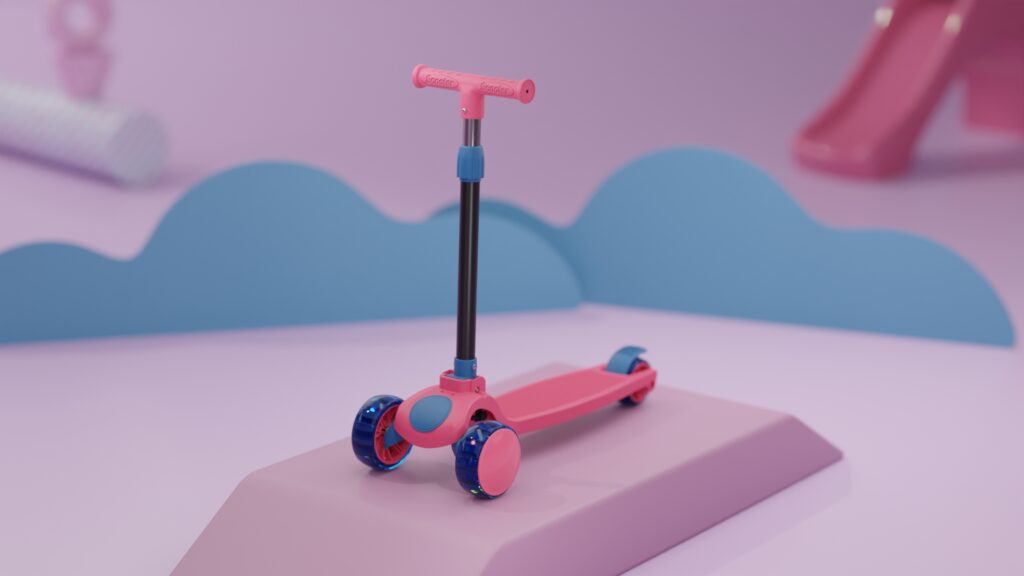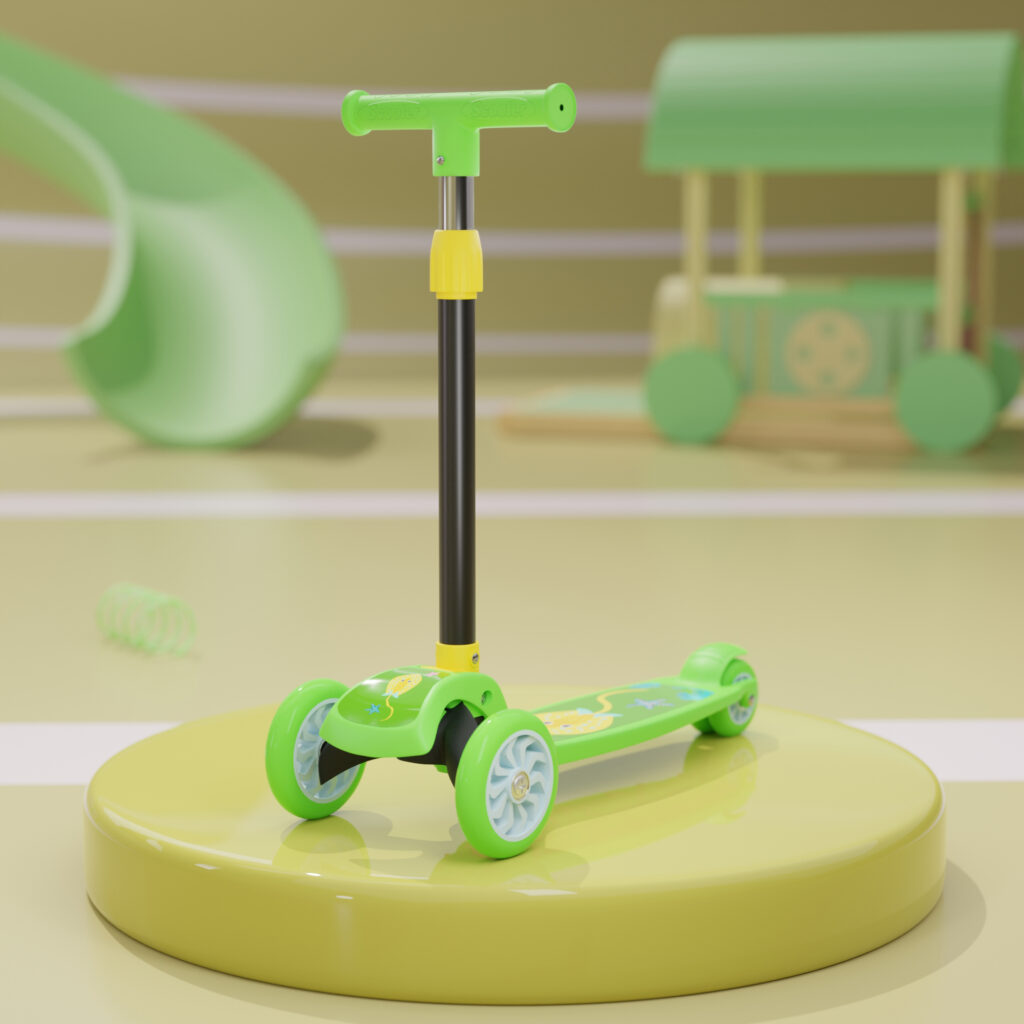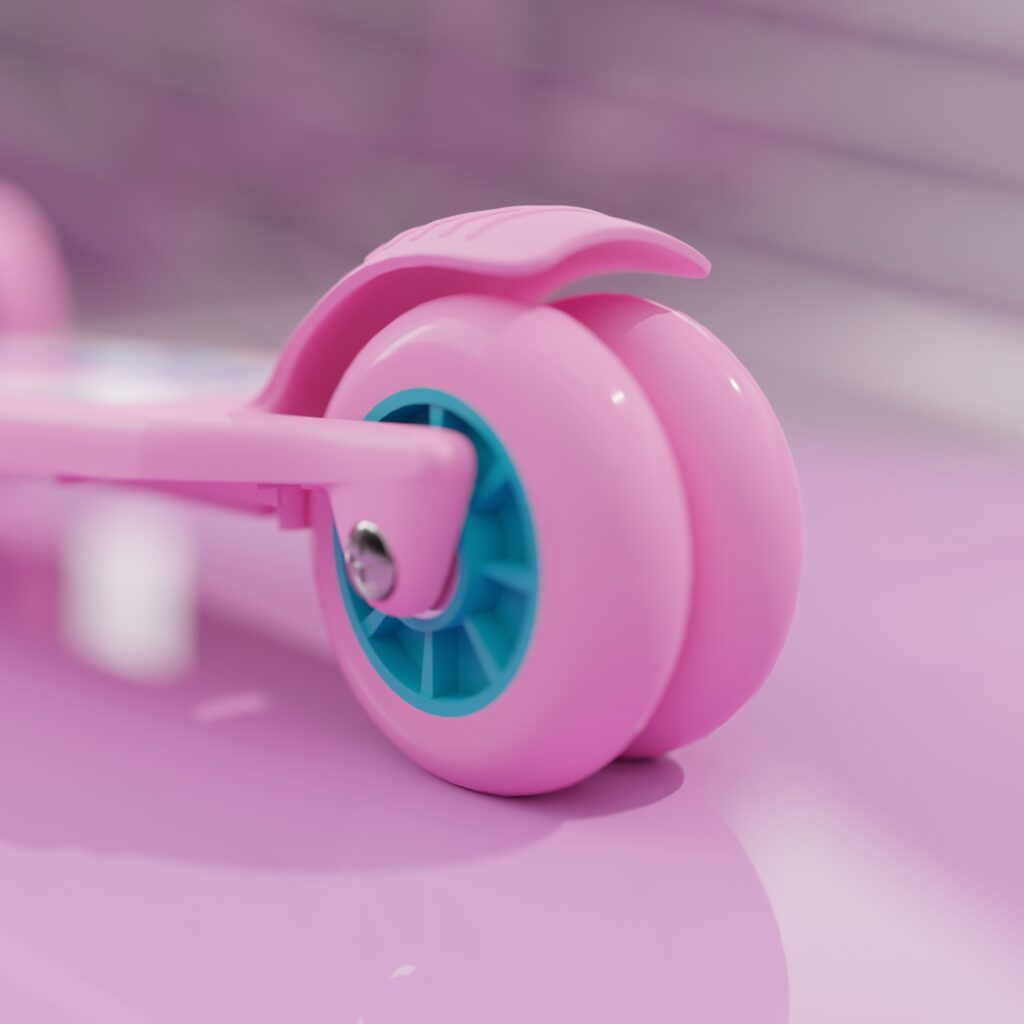The 3 Wheel Kids Scooters: Features, Pros and Cons
If you think a pushbike or a 3-wheel scooter would be the ideal gift for the active child in your life, you’re right! The selection available will put a smile on any child’s face. With the wide range of colors, styles, and age levels, choosing the best 3-wheel scooters for your little one to enjoy shouldn’t be challenging.

LED WHEEL KIDS SCOOTER
Bidso put a lot of thought into this three-wheel scooter design in terms of durability, safety, comfort, and style. They’ve done it all.
Our Top Picks
- Best Overall 3-Wheel Scooter – https://bit.ly/bkickscooters
- We have multiple options at Bidso. Younger toddlers can use the seat and push with their feet, then graduate to standing on the foot deck and pushing with one foot. Lean-to-steer technology lets kids practise their balance and coordination, and cool kid-friendly extras like light-up wheels make this scooter exciting to ride. Kids can use this scooter for several years with a handlebar with four adjustable positions and a weight limit of 110 lbs.

WITHOUT LED WHEEL KIDS SCOOTER
Best Overall 3-Wheel Scooter – https://bidso.com/categories/7f122cd7-7424-4e37-b4c9-76a1f3afc22d
- We have multiple options at Bidso. Younger toddlers can use the seat and push with their feet, then graduate to standing on the foot deck and pushing with one foot. Lean-to-steer technology lets kids practise their balance and coordination, and cool kid-friendly makes this scooter exciting to ride. Kids can use this scooter for several years with a handlebar with four adjustable positions and a weight limit of 110 lbs.
Technical Specifications
Having had the opportunity to experience the Bidso scooter firsthand, I must express my profound admiration for its exceptional design and performance.
One aspect of our Model that immediately captures attention is the vibrant spectrum of colour options it offers, enabling a delightful degree of personalization and self-expression. The aluminium T-bar, crafted to resist scratches, features three intelligently designed preset stages, effectively accommodating riders of varying heights.
The integrated design of the foot deck, fortified axle bearings, and precisely crafted components synergistically contribute to the scooter’s truly remarkable weight-bearing capacity, supporting riders of up to 132 lbs with unwavering stability.
Among the many remarkable features, the illumination of the large, extra-wide wheels as they begin to rotate is particularly captivating. These pretty LED-illuminated wheels will need batteries to work. It is well worth the effort as they provide fantastic visibility if your kids take the scooters out in low-lit areas in the evening.
An undeniable highlight of Bidso model is its ingenious Lean-to-Steer technology, which is a great aid in smoothing out tricky turns and providing excellent support if your kids struggle with keeping their balance or coordination. Witnessing my child hone these abilities while deriving immense pleasure from the experience has been profoundly rewarding from a parental perspective.
Safety, a major consideration, is effortlessly incorporated into Bidso Model design thanks to the thoughtful inclusion of a full-covered, metal-enhanced rear fender brake. This gives kids much better speed control and easily execute secure stops.
Pros
- Impressive design and performance
- Adaptability and comfort
- Safety focus
Cons
- Relatively expensive compared to similar scooters
Preferences For Features In 3-Wheel Scooters
The below percentages indicate that safety is the main concern for parents when choosing a 3-wheel scooter for kids, followed by durability and adjustable height.
Rolling With The Best: A Guide To 3-Wheel Scooter Shopping
While your kid can have much fun riding on a scooter, it is much easier if the toy is ride-ready. Not many children enjoy receiving a gift that they have to grow into or don’t have the skills to learn for a while; this means you have to choose the most appropriate scooter for your child at the start.
The Brake Design
Some scooters have brakes, and other models encourage the child to learn how to use their foot to slow the scooter down. You usually see three braking systems with scooters: Rear-wheel braking, front-handlebar braking, or manual braking.
Rear-wheel braking systems are the metal pedals above and over the rear wheel. When you need to brake, you press down with your push-off leg and slow the scooter down. Rear braking systems are safer for less experienced and skilled children because they slow the scooter from behind.
Stopping a scooter from the front places a force against the scooter’s and the child’s momentum. And because the wheels are so small and low to the ground, the scooter’s momentum will slow down, but the child’s momentum will not. This often results in the child falling forward, over, or on the scooter.

Rear Wheel Braking System
Handlebar Braking System
Ease of Assembly?
When purchasing a three-wheel scooter, you must consider whether an assembly is required, how much assembly is required, whether specific tools are needed, etc. Some scooters need minimal assembly, such as clicking the T-Bar in place.
Look at the review section to determine how complicated the assembly process was and if you need more than one person. Review a few reviews and determine if there are frustrated parents and how many. These reviews should give you an idea of assembly difficulty.
The Types of Wheels
Different wheels are suitable for different terrains. Different wheel sizes and placements provide different levels of stability. Some scooter wheels have LED lights that can light up when the scooter is ridden.
First, look at the wheel material. Polyurethane is the standard wheel material for scooters, the same material used for skateboard wheels. Polyurethane will provide a smooth ride on multiple terrains.
Next, consider wheel sizes. The rule of thumb is that the bigger the wheel, the greater the stability. But don’t buy the largest wheel size available because wheels too big for your child will make it difficult for them to kick off and push the scooter.
What about wheel placements? There are two ways the three wheels can be placed – one wheel in the front and two at the back, or two in the front and one at the back. The most common and preferred way is with two wheels in the front. It increases the child’s stability on the scooter and helps them remain balanced during turning.
Is It Foldable Or Collapsible?
If you are a travelling family and your kids like bringing their toys, consider purchasing a scooter that can fold. During our research, we noticed that a few of the three-wheel scooters could not fold for storing or transport, but the T-Bar can be easily removed. We recommend you consider how important the folding aspect is to you and your family or if removing the T-Bar is sufficient for your storing and traveling needs.
Steering Design
There are two steering options to consider: regular steering and lean-to-steer.
Regular steering is similar to steering a bicycle; the handlebar can twist almost completely around. In the case of the scooter, it can do a 360-degree twist. Most manufacturers recommend this steering for older kids who have experience with scooters and can maintain their balance.
Lean-to-steer is when the handlebar is not twisted to turn the scooter; instead, the child learns in the direction they wish to go. This provides more control and stability over the scooter. Manufacturers recommend this steering type for younger kids still developing their balancing skills.

Lean-to–Steer

Regular Steering
Recommended Age and Weight Range?
For safety reasons, always ensure your child is within the recommended age or weight category for the product. These parameters are set to protect your child and ensure the product is built for their age category. The age category determines the height at which the scooter handle is built, the size of the foot deck, etc.
Brand Names
If you prefer buying toys, your children will cherish them and pass them on to their kids; you will look at the top kids’ toys’ name brands. They offer the highest quality toys with timeless features and durability. The prestige of owning a classic kids’ brand toy means the price tag will always be higher. If you pass the toy on to your other child, this will be a good investment.
The brand is a personal choice for parents; your child will unlikely prefer one brand over another. They are likely to like the scooter’s decoration: Barbie, Disney, or the latest superhero.
What Is Your Budget?
As a parent, you must factor in how long you want your kids’ scooter to last, whether you want it to become a valued family toy passed down to other relatives, what features it needs to have, and what price fits your budget.
Prices for kids’ toys vary quite a bit. There are 3-wheel scooters under the $100 price tag that are decent and good value, and there are the high-end, recognizable name-brand models that will push prices well over $200. When you get into electrically powered scooters, your price range will be upwards of $500 for a high-quality brand name.
How Easy Is It to Replace Parts?
If you’ve paid for an upscale, name-brand scooter to last the family many years, you’ll want to know if there’s any part of the toy that can wear out over time. If this happens, you must choose established scooter brands with spare parts and warranties to fix or replace the part.
What Are The Benefits Of Riding A 3-Wheel Scooter?
Three-wheel scooters for kids have become increasingly popular in recent years, and for good reason. Here are some benefits of using a 3-wheel scooter for kids.
- Stability: Three-wheel scooters offer more stability than traditional two-wheel scooters. The additional wheel provides more balance, making it easier for young children to ride and reducing the likelihood of accidents.
- Easy to Learn: Kids can learn to ride a 3-wheel scooter quickly and easily. Unlike a traditional two-wheel scooter, which can take time to master, 3-wheel scooters are intuitive and easy to use. This makes them great for younger children who are just learning to ride.
- Safety: With a lower center of gravity and a wider base, 3-wheel scooters are safer for kids than traditional two-wheel scooters. They are less likely to tip over, and children are less likely to injure themselves if they fall.
- Exercise: Riding a 3-wheel scooter is a great exercise for kids. It helps develop their balance, coordination, and motor skills and provides a fun way to stay active.
- Confidence Building: Mastering a new skill, like riding a scooter, can be a great confidence booster for kids. Riding a 3-wheel scooter can help build their self-esteem and give them a sense of accomplishment.
- Outdoor Fun: Riding a 3-wheel scooter is a fun outdoor activity that kids can enjoy alone or with friends. It encourages them to get outside, explore their surroundings, and enjoy the fresh air.
Overall, 3-wheel scooters offer a fun, safe, and healthy way for children to stay active and develop important skills.
What Are The Safety Precautions For Kids Riding 3-Wheel Scooters?
- Wear a helmet: Always wear a properly fitting helmet when riding a scooter. A helmet can protect the head and prevent serious injury in a fall.
- Wear protective gear: In addition to a helmet, children should wear knee pads, elbow pads, and wrist guards to protect themselves from scrapes, cuts, and other injuries.
- Use the scooter in a safe environment: Children should ride on smooth, flat surfaces away from traffic, pedestrians, and obstacles.
- Check the scooter before each use: Inspect the scooter for loose parts, frayed cables, or other signs of damage. Make sure the brakes work properly, and the wheels are secure.
- Follow traffic rules: Teach children to follow traffic rules when riding their scooters, such as stopping at stop signs, using hand signals to indicate turns, and staying on the right side of the road.
- Supervise young children: Children under eight should be supervised by an adult when riding a scooter.
- Ride safely: Encourage children to ride at a safe speed and avoid riding downhill or on steep inclines.
- Avoid distractions: Children should avoid distractions like using a phone or listening to music while riding their scooters.
- Teach children how to stop: Ensure they know how to use the brakes to stop their scooters safely.
- Don’t ride in bad weather: Children should not ride their scooters in the rain, snow, or other bad weather conditions, as it can make the surface slippery and dangerous.
Frequently Asked Questions
Which 3-Wheel Scooter is Best for Your Child?
For any child under five, a three-wheel scooter is a must-have item. When they master the skill of this fun activity, they can progress onto a scooter with more advanced features, such as those powered by electricity or a motor. Because appropriate age-level scooters for toddlers and young kids have three wheels and not two, they offer better stability.
That extra wheel, usually on the front of the scooter, is additionally stable by the back wheel’s extra width. Another feature 3-wheel scooters for kids can offer is a broader deck and easy-grip handles, making the “lean to steer” aspect of scooter riding easier for a child to learn quickly.
What is Lean-to-Steer?
What’s the difference between leaning to steer and twisting the handles? When faced with their first scooter, a person’s instinct is to try and steer the deck by turning the handles from left to right. Fortunately, a child picks up the correct way to steer a scooter by leaning in the direction they want the toy to go, changing the straight path of the scooter to a gentle curve. When the rider emerges from the lean, the scooter goes straight again.
Does the Scooter Fold for Storage?
This will depend on the individual scooter you are considering. While most three-wheel scooters on our list do not fold for storage, some do. Although some scooters might not fold, the handle is often easily detachable for storage or transportation.
What Age is a Three-Wheel Scooter for?
Three-wheeled scooters are typically best for kids between 2 and 5. The three-wheeled design is more stable for beginning riders who have not figured out how to balance yet, and they typically have decks wide enough for two tiny feet to stand side by side instead of the one foot behind the other stance required on more narrow two-wheel scooters. Three-wheeled scooters may also have shorter handlebars and rear foot brakes, which are easier for young children to operate. That said, if the scooter has an adjustable handlebar that you can raise higher, it can be used by older children who may struggle with the coordination required for a two-wheel scooter as long as they are under the weight limit.
Do I Need Adjustable Handlebars?
Adjustable handlebars are not necessary depending on your child’s age, size, and abilities, but they can be nice. If your child is an average-sized toddler likely to use the scooter for no more than 2-3 years, then handlebars aren’t a must-have. If your child is tall for their age or might need a few extra years on a three-wheel scooter before switching to a two-wheel scooter, an adjustable handlebar that can grow with your child is a feature you should look for.

👀 Dating for sex. Go - yandex.com/poll/LZW8GPQdJg3xe5C7gt95bD?hs=a949c2dd79509c5bc35202b31e400fb4& Notification # 3151 👀
December 4, 20252yvsdo